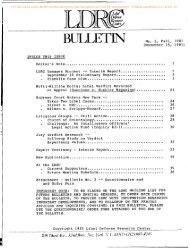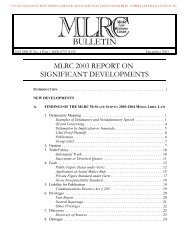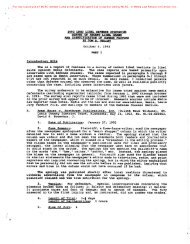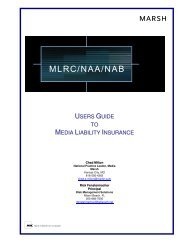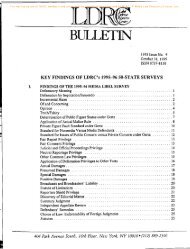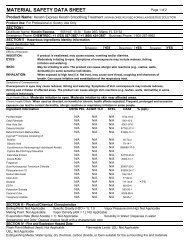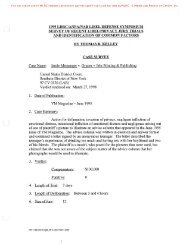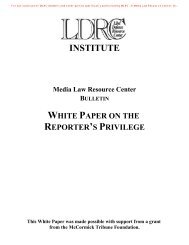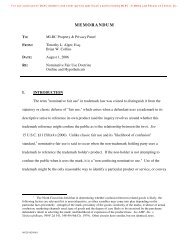2006 MLRC/NAA/NAB LIBEL DEFENSE ... - Directrouter.com
2006 MLRC/NAA/NAB LIBEL DEFENSE ... - Directrouter.com
2006 MLRC/NAA/NAB LIBEL DEFENSE ... - Directrouter.com
Create successful ePaper yourself
Turn your PDF publications into a flip-book with our unique Google optimized e-Paper software.
For exclusive use of <strong>MLRC</strong> members and other parties specifically authorized by <strong>MLRC</strong>. © Media Law Resource Center, Inc.Throughout the pre-trial motions, trial, the charge conference, and now in his posttrialmotion for a new trial, plaintiff has maintained that: (1) he will overturn New YorkTimes v. Sullivan, (2) the standard of proof for actual malice should be preponderance of theevidence rather than clear and convincing evidence, and (3) reckless disregard “should berevised to mean that the defendant engaged in highly unreasonable conduct constituting anextreme departure from standards of investigation and reporting.”Plaintiff contended that defendants acted with reckless disregard of the truth in relyingon the grand jury testimony of the special prosecutor’s investigator because they should haveknown that the investigator and the special prosecutor were biased and attempting to indictplaintiff for prosecutorial misconduct through the testimony about Gorajczyk’s examinationof the Buckley boots and plaintiff’s alleged conversation with him. Plaintiff furthercontended that the reporters should not have relied on the grand jury testimony because itwas hearsay, but instead should have researched court records and transcripts from theNicarico murder trials that reached back over fifteen years.17. Defendant’s Theme(s):This misattribution was a mistake that was not a material error. The paraphrase “keepyour mouth shut” was not defamatory. The 29 words were not defamatory per se. Plaintiff’sreputation was harmed by the DuPage 7 indictment, not the 29 words. Damages, if any, weremitigated by the other media articles on the same subject.There was no actual malice. The 29 words were a fair paraphrase of the grand jurytestimony. The 29 words were substantially true. Plaintiff’s joint enterprise/venture theoryagainst Armstrong was not pled and could not survive First Amendment scrutiny under NewYork Times v. Sullivan. The source of the grand jury transcript was plaintiff’s own counsel,who did not indicate that there was anything unreliable in the testimony. The grand jurytestimony was sworn and, therefore, reliable. The journalism that resulted in the subjectseries and succeeding series by The Chicago Tribune on matters of prosecutorial misconductand wrongful convictions was on a serious matter of public concern and a public service.18. Factors/Evidence:a. Pre-existing attitudes of the venire towards the plaintiff, defendant,or issues:See jury debriefing below.b. Sympathy for plaintiff during trial:See jury debriefing below.40



